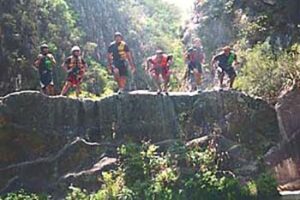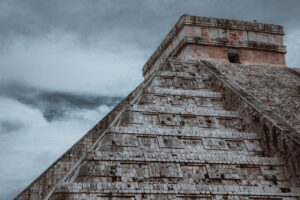
In Off-Season Tulum, More Turtles than Tourists
By Valerie Hamilton
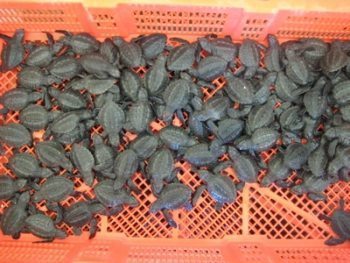
If the Caribbean’s balmy turquoise charms are doubled by wintry weather at home, the argument could be made they’re halved in close succession to a steamy summer. Heat, humidity, mosquitoes – been there, done that.
Mexican tourism is down for the count anyway, and along the torrid coastline of the Riviera Maya in the off-season, it barely seems to have a pulse.
But it turns out there’s more life on these deserted beaches than you might think – you just have to dig a little.
Tulum’s epic seven-mile beach is bordered by various humming, buzzing thicknesses of the scrubby jungle, cut through by a two-lane road.
Between the road and the Caribbean are dozens of low-key bungalow hotels playing variations on a theme: thatched roofs, yoga studios, a landscape of soft white sand.
Cabanas La Conchita in Tulum
Our digs, Cabanas La Conchita, are a cluster of open-beamed cottages in Italian colors on a rocky, half-moon cove. Instead of a lobby, there’s a sandy-floored tropical garden, brimming with coconut palms and palmetto, leading from the entrance through to the beach.
But where the sand should have been, in my tropical fantasy, scattered with coconuts and cavorting lizards, it’s crowded instead with half-buried columns of chicken wire eighteen inches high. A poorly planned vegetable garden? A maximum-security prison for rabbits?
“Sea turtles,” says Eduardo Rosales, the hotel receptionist, as proud as a new father. “These are our sea turtle nests.”
Seven of the world’s eight species of endangered sea turtle lay their eggs on the beaches of Mexico, and four of these nest on its Caribbean coast, on beaches where tourism increases its footprint every year.

The challenge for conservationists is to take this impossible resource conflict and turn it into cooperation, involving hotels like La Conchita and their guests in keeping beaches turtle-friendly and keeping turtle nests safe.
It works, in no small part because the turtles and the tourists keep different schedules: the turtles nest, incubate and hatch between spring and early fall, when you and I are barbecuing at home, and by the time the snow drives us down to their nesting grounds, the mother and babies have hightailed it for the open sea.
But it’s just October now, and we’re picking our way from empty cabana to empty cabana through a miniature obstacle course of wire and tidy signs identifying loggerhead, green and hawksbill turtle eggs sleeping just under the sand.
Digging her Nest
In nature, the nest that a mother turtle digs in the sand is a natural incubator, just the right depth to protect from the elements without giving up the sun’s warmth. But ripening eggs and hatching babies are vulnerable to predators, like the crabs skittering across the path as we pass, not to mention that protecting their natural nests would involve closing off parts of the beach, an unrealistic proposition in this burgeoning tourist town.

So over the last eight years, volunteer turtle squads at La Conchita and other hotels have learned how to dig up the eggs from the beach and resettle them in manmade nests, labeled with species, date, and the number of eggs, and fenced off from potential dangers until they hatch and are released into the sea.
Ninety-Seven Nests
Rosales tells me they’ve had ninety-seven nests so far this year, three times the eggs normally laid in this cove. “We’re starting to run out of room,” he says, but his smile suggests that’s a good thing. Just a lucky year?
“They don’t like light,” he says, “and on the big beaches, someone always has the light on.” Like many Tulum hotels, La Conchita only has generator-sourced electricity three hours a day, from seven to ten PM, and Rosales says they cut it off when they discover sea turtles coming up to nest.
When the lights go out, “sometimes the tourists are surprised, but then we explain what’s going on,” he says. “They understand what we’re trying to do, and they want to help.”
A Lucky Year in Tulum
But if it’s a lucky year for La Conchita, it’s an unlucky one for us. The next due date is five days from now after we’ve gone. We swallow our disappointment, gazing forlornly at the empty sand, and try not to trip over the corrals on our way to breakfast.
The days pass in a torpor of swimming, Scrabble, and scratching mosquito bites that everyone knows ought to be left alone. We watch iguanas stare each other down, we attempt handstands in bottle-glass water, we giggle at dreadlocked hippies playing coconut drums, we run naked on the empty, endless beach.
Salsa at La Zebra
There’s a live salsa band down the road at La Zebra, where locals and people who dance like them spin and stomp while our left-footed posse sits in the sand, passing around a bottle of rum. And then, one evening as we come in the gate, the guard says a nest has hatched, early, and would we like to help dig it out?
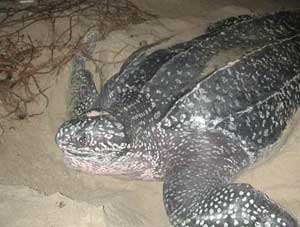
A small crowd has gathered in the darkness of the garden, and I wonder if there have been guests at the hotel all along, waiting in their bungalows for the turtles to come.
The white sand is lit by flashlights, and where the miniature wire corral was, there is now a dark opening in the ground. Rosales arrives with an empty blue beer cooler, which he sets down next to the nest. “Who wants to help?”
Well, of course, I do. I kneel in the cool sand, feeling like a kid pulled out of the crowd for a magic trick – will I conjure a rabbit, or is someone going to cut me in half?
The moment we touch the first one, they all wake up. The quiet stack of turtles is transformed into a crush of adorable reptilian determination, clawing its way to newborn freedom – and they’re fast. My co-volunteer is unfazed.
He transfers them to the cooler, counting out loud. After three, he gives me a look that says, are you helping, or are you helping? In what I imagine to be a fearless and confident manner, I reach for one of the little guys, but he’s scrabbling so frantically for a way out that it’s hard to figure out which part of him to grab. I pinch a flipper – wrong – and let it go again. They’re flapping like crazy.
I try again, working for my hand through the shuffling stack of bodies, so strangely cool for living things, until I get a thumb and finger, gently, around a torso. “Four.”
It gets easier as we go. Soon I’m scooping up handfuls of them, three or four at a time. They’re so small I could close my fingers around one if it would just stop moving.
“Thirty, thirty-one, treinta y dos”. Another two are already making a break for it, out of the pool of light. My co-volunteers fingers snap them up like so many tortillas from a grill and drop them in with the others. “Treinta y tres, treinta y cuatro.”
The noise from inside the cooler is rising now, an echoey plastic shuffling and bumping of hard little heads against the wall. They’re either very determined, or very near-sighted, but whichever it is, I understand why they’re called loggerheads – they don’t give up.
The cooler fills, and the nest empties, ninety-eight, ninety-nine. We’re reaching up to our shoulders in the pit in the sand, and there’s nothing left but some eggshells, like scraps of white plastic, covered in grit. “That’s it?”
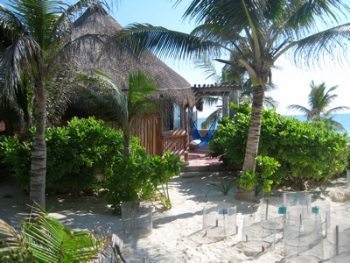
“There were one hundred twenty eggs,” says a fellow guest named Luna, reading the sign.
And suddenly I understand why we’ve been counting.
My co-volunteer is digging in again. “Here.” He pulls out unhatched eggs the size of deflated ping-pong balls. “One hundred two, one hundred three—“
And then a miracle: a sandy little body, wriggling with life. Two, three – I’m back to my shoulder in the sand, digging for the babies who were laid first, or started in the wrong direction. “Two more.”
Two more sandy little bodies, stunned from their ordeal, start flapping wildly when they see the light. One hundred four! With the unhatched eggs, that makes one hundred twenty – we’ve got them all, and we cheer like it’s the World Series of turtle hatching and our guys just hit a home run.
These turtles are a little premature, and Rosales decides to give them a day’s rest in the beer cooler before they strike out into the wild blue. The next night, we reconvene, led by Maru Torres, a biologist working to collect turtle hatching data on town beaches.
While we were stuffing ourselves with quesadillas at the beach today, another nest – green sea turtles – has opened up, but tonight Torres wastes no time with volunteers or coochie-coo. She digs the babies out of the sand, counting silently, and piles them on top of last night’s still-restive newborns in five minutes flat, while we watch in awed silence – so this is how it’s done.
When the eggshells are collected and the numbers noted, she dusts the damp sand from her arms, and announces, “time to let them go.”
We follow her in the dark, a silent line of pilgrims with a solemn offering in our beer cooler. There’s the faintest glow from the white sand, but the sea, so startling green in daylight, is only a rushing blackness at its edge.

The exhilaration we felt as we pulled the scrambling babies from the sand is suddenly replaced by a parent’s anxious dread: the world is so big, and they’re so small.
Torres has told us that for every thousand hatched turtles, only one will survive to adulthood. This number is no longer an abstraction.
While her assistant tips the cooler to the sand, Torres wades into the surf and turns on a flashlight. The two-hundred-some hatchlings are supposed to run for the light, but they don’t – instead, they’re scuttling over our feet, up the hillocks in the sand, anywhere but toward the shimmering tideline and the sea beyond.
We’re squatting, searching for them with both hands to set them back on course, but for every one we set at the water’s edge there are four more disappearing into the darkness again, like so many wind-up toys with wonky wheels.
“Don’t drop them!” calls Torres. Easy for her to say, standing in the water with her flashlight.
I spot one in the shadows and I scoop it up, then place – not drop – it into the wash of the surf. It’s promptly carried back to me and left flapping on its back in the sand. But on the next try, it’s pulled forward, and it disappears into the waves. We gather the shuffling little bodies in wet hands and, like so many kindergarten teachers, try to set them off in the right direction.
It’s easy to forget that if we weren’t here, they’d figure it out for themselves, but in minutes, nature has taken over. Our charges have been delivered to the sea, and we stand in the darkness, listening to the white noise and contemplating the true meaning of the expression empty nest.
On our last morning, we walk barefoot down to the beach for an early swim. We’re alone, as usual – but the deserted beach feels different now: incipient, not empty; quiet, and alive. The water is a silver mirror in the flat light; swelling waves lift us off our feet and set us down again in the soft sand; pelicans glide inches above the surface.
There’s a fishing boat pulled up on the beach, and past it, a trail of deep grooves in the sand leading from the water to the garden wall, where it looks like someone has dug a fresh grave.
A sea turtle
We’ve seen fresh turtle tracks before, even watched a mother come out of the sea and dig her nest in the moonlight. This is different. The turtle that dug this nest was born here just like the hatchlings we released last night, and someday, with luck, one of them will come back to nest right here where we’re standing, just as her mother did and her mother before her.
We follow the tracks out of the water and up the beach, thirty yards or so, and then back down to the water’s edge, noticing how the turtle had neatly circumnavigated the spot where we had been sitting in the dark, listening to the waves and not seeing anything at all. The nest itself is untouched – Rosales and his team haven’t gotten to it yet. We imagine a hundred fresh eggs under the sand, just starting to stir with life.
Stay: Cabanas La Conchita, Carretera Tulum a Boca Paila km 5, off-season bungalows starting at $140/night, no phone, reservations@differentworld.com
Eat/Drink: La Zebra, Carretera Tulum a Boca Paila km 8.2, +52-1-984-1154726, lazebratulum.com
Valerie Hamilton is a journalist and co-author of seventeen-and-counting travel guides for Fodor’s, Frommer’s and Travel & Leisure Online.
- Missouri Sports Travel Adventure: From Landmarks to Ballparks - January 21, 2026
- What First-Time Visitors Get Wrong About Visiting Iceland - January 15, 2026
- Bareboat Charter vs all-inclusive Crewed: Which Luxury Charter Fits You? - December 29, 2025




